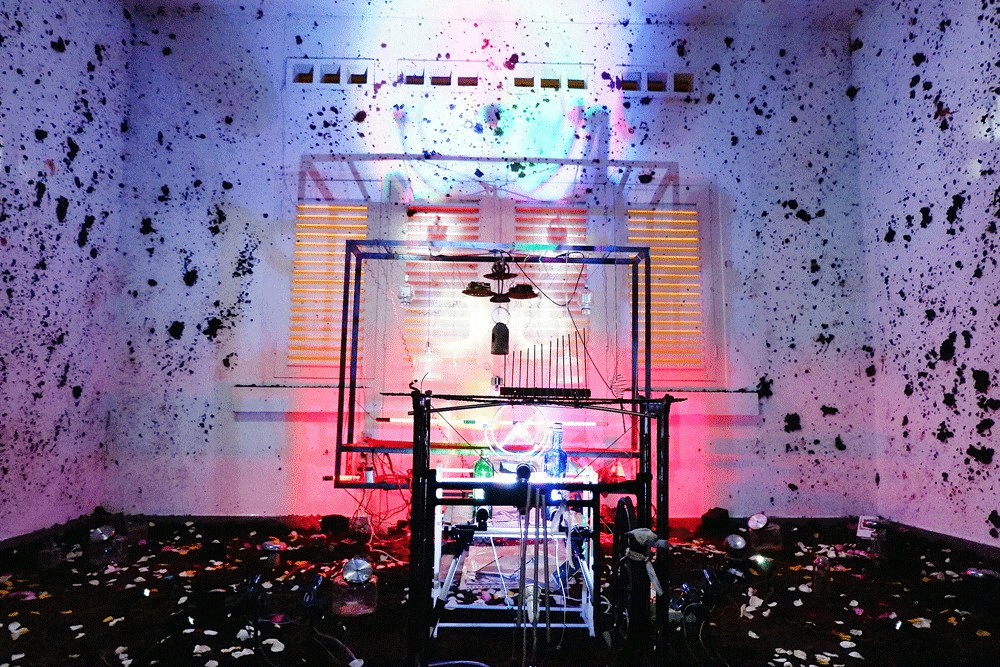Popular Reads
Top Results
Can't find what you're looking for?
View all search resultsPopular Reads
Top Results
Can't find what you're looking for?
View all search resultsInstrumenta 2018: Sandbox a game universe in an art gallery
Change text size
Gift Premium Articles
to Anyone
The Instrumenta 2018: Sandbox Festival offers game, art and technology exploration.
Many streets across the country are named after national hero Teuku Umar to honor his fight against the Dutch in Aceh from 1873 until his death at the hands of Dutch troops in 1899. Teuku, with his signature kupiah meuketophat, was also once featured on the Rp 5,000 (35 US cents) banknote.
While streets and the banknote recognized his heroic deeds, a board game called Toekoe Oemar Spel (Teuku Umar Game) portrays Teuku in a different light.
The game was produced by Dutch company Jos. Vas Dias & Co. in 1896 when Teuku was still battling the colonizers.
In the checkers-like game, Teuku is represented as a tall, dark game piece who tries to escape from 25 Dutch soldiers — represented by white pieces.
One player has Teuku, while the opposing player controls the 25 Dutch soldiers. The Dutch win if the soldiers manage to catch Teuku within the 15-minute playing time.
Toekoe Oemar Spel is probably hard to find today, but artist Zaini Alif managed to create a replica, which is featured at the Instrumenta 2018: Sandbox International Media Arts Festival, running from Nov. 11 to 30 at the National Gallery in Jakarta.
Held by the Education and Culture Ministry, the festival highlights “the interrelationship between art, game culture and media technology”.
The ministry’s art director, Restu Gunawan, said the festival was a response to the rising popularity of games and technology-based art exploration in Indonesia.
“Inevitably, playing games is a universal human activity. People in Indonesia continue to create and play various types of games in their daily lives, from traditional games, arcade games to gadget-based games,” he said.
Curated by Bob Edrian and Gesyada Siregar, 29 works in the festival comprise games and artwork with a touch of media technology, such as digital art, virtual art, computer animation, computer graphics, video games and computer robotics.
The games and artwork are created by 34 individuals from various backgrounds — such as artists, game designers, musicians, photographers and filmmakers — from Indonesia and five other countries, including Japan and the United States.
According to the festival’s artistic director, Agung Hujatnikajennong, many contemporary artists have used games as their artistic medium in the last two decades.
“In this festival, the artists use media technology as a tool to create symbolic languages in delivering critical messages on anything, including the media technology itself,” he said.
Art and games have a lot in common, Agung says. They are not only fun and addictive but also require human creativity and skills in its creation.
For participating artist Moch Hasrul, games go beyond that. Games, as he described, captured social, cultural, political and economic phenomenon in society, including human characteristics, such as competitive nature. In politics, for example, politicians act like they are playing a game. They will do anything to gain a victory.
Hasrul captures the competitive politics world in his interactive arcade game, The Age of Bibitulit. The game consists of a pool table and two different types of toys, which sit face-to-face on the table as if they are going to fight in a war zone.
To play the game, you need insert an Rp 1,000 coin first. Then you have to clap and cheer as loud as possible to stimulate the toys to move. The louder the noise you make, the quicker the toys will move.
The coin represents capital or money, which Hasrul described as the source of all political games, while the claps and cheers represent brouhaha in politics.
Meanwhile, Hardiman Radjab shares a story of the urban life in Jakarta through his kinetic and video installation titled Urban Cowboy.
The artwork comprises two old suitcases hung vertically on the roof. The upper suitcase is equipped with two wings and a tail. They flap slowly as if the bag is flying like a bird. The lower suitcase projects images of Jakarta urban life on the wall. The images include Jakarta’s notorious traffic congestion and busy terminals and train stations, where passengers jostle one another.
“The suitcase is the symbol of busy people in Jakarta who commute from one place to another every day, and the flapping wings represent their endless energy,” the festival’s artistic director Agung explained.
Agung hoped Instrumenta could enrich people’s understanding about game and media art. He encouraged visitors to be a player by trying out various games displayed in the gallery.
“Playing is an important activity in human life,” he suggested.











